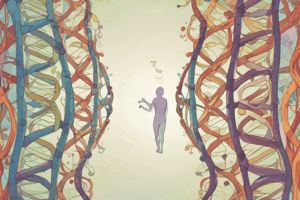Podcast
Questions and Answers
What are the basic modes of inheritance for single-gene?
What are the basic modes of inheritance for single-gene?
- Autosomal dominant inheritance
- X-linked recessive
- Y-linked
- All of the above (correct)
Human females produce gametes with two possible combinations of chromosomes.
Human females produce gametes with two possible combinations of chromosomes.
False (B)
What is the term for traits that display continuous variation due to genetic and environmental factors?
What is the term for traits that display continuous variation due to genetic and environmental factors?
complex or multifactorial inheritance
What type of inheritance is observed when an allele is only expressed if two copies are present?
What type of inheritance is observed when an allele is only expressed if two copies are present?
Which type of inheritance primarily involves the X chromosome?
Which type of inheritance primarily involves the X chromosome?
The smaller Y chromosome contains genes responsible for the initiation and maintenance of _____.
The smaller Y chromosome contains genes responsible for the initiation and maintenance of _____.
Males express all the alleles present on the single X chromosome they receive from their mother.
Males express all the alleles present on the single X chromosome they receive from their mother.
Who is known for their work in X-linked inheritance using Drosophila?
Who is known for their work in X-linked inheritance using Drosophila?
An individual heterozygous for an autosomal recessive allele is known as a _____.
An individual heterozygous for an autosomal recessive allele is known as a _____.
Match the following conditions with their associated chromosome:
Match the following conditions with their associated chromosome:
Flashcards are hidden until you start studying
Study Notes
Pattern of Inheritance
- Inheritance patterns depend on whether alleles are on autosomal or sex chromosomes and whether they are dominant or recessive.
- Five basic modes of single-gene inheritance:
- Autosomal dominant
- Autosomal recessive
- X-linked dominant
- X-linked recessive
- Y-linked
- Mitochondrial
Homogametic and Heterogametic
- Females are homogametic, producing gametes with only X chromosomes (XX).
- Males are heterogametic, producing gametes with both X and Y chromosomes (XY).
- During meiosis, sex chromosomes are separated into different gametes.
Non-Mendelian Inheritance
- Complex traits show continuous variation, influenced by both genetics and environmental factors.
- Example traits include human height and weight, affected by gene interactions and environmental influences.
- Such traits are classified as complex or multifactorial.
Autosomal Inheritance
- Autosomal Dominant:
- Phenotype observed with one copy of the dominant allele (heterozygous or homozygous).
- Autosomal Recessive:
- Phenotype observed only with two copies of the recessive allele (homozygous).
- Heterozygous individuals (carriers) do not express the phenotype but can pass it on.
Sex-linked Inheritance
- Most sex-linked characteristics are X-linked due to limited genetic information on the Y chromosome.
- X chromosome contains hundreds of genes unrelated to sex determination.
- Males express all alleles on their single X chromosome, making dominance or recessiveness irrelevant for X-linked traits.
- Conditions linked to the X chromosome include haemophilia, muscular dystrophy, and color blindness.
Historical Context
- Thomas Hunt Morgan's experiments with Drosophila (fruit flies) advanced understanding of X-linked inheritance.
- Morgan aimed to challenge Mendelian ratios and discovered a white-eyed male fly, crucial for his studies.
- The notation used: XR indicates the red eye allele (dominant), while Xr indicates the white eye allele (recessive).
Studying That Suits You
Use AI to generate personalized quizzes and flashcards to suit your learning preferences.




